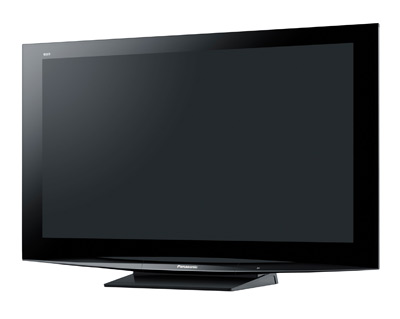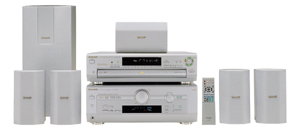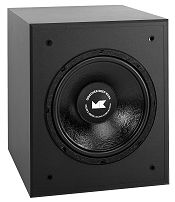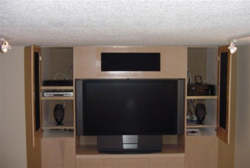|
|
||||
The problems/hints Axiom cites are: Too much light (possibly the biggest problem I've noticed); movie dialogue that's hard to understand; improperly placed surround speakers; the importance of larger speakers for a larger room; and why your subwoofer and screen location are crucial to a great experience.
Too much light is a double-edged sword. On one hand, it can stem from a home theater that's set up in a room with too much sunlight – rooms, such as living room or family room, that share their home theater duties with others. Though it's particularly crucial with a front projection system, in my experience most people with such setups have them in dedicated rooms where they can control the light.
 But LCD's and plasmas, which can be placed just about everywhere, have reflective screens and direct sunlight can make them almost unwatchable. Why bother having a screen? Close the curtains!
But LCD's and plasmas, which can be placed just about everywhere, have reflective screens and direct sunlight can make them almost unwatchable. Why bother having a screen? Close the curtains!
Axiom's talking about another type of brightness, though, and it's equally valid: TV pictures that are often adjusted brighter than they need be. TV brightness is generally set at the factory so it looks good in a store environment, but it's too bright for most homes.
Your first tweak, therefore, is to turn the darn thing down! Some TV's come with an "ISF" or other such calibrated setting, which is a great place to start if your TV has it. If not, try the movie setting, whether it's called Cinema, Movie or whatever. You'll probably find it darker than you're used to – which brings back the importance of controlling the room's ambient light as well – but it will not only give you a more lifelike picture it'll also be easier on your eyes. And you'll be getting closer to the filmmaker's original intention of what you should see.
There are also calibration discs, either DVD or Blu-ray, you can use to test and/or adjust your TV's geometry – whether or not all the pixels are where they're supposed to be – and various other settings including the color. My favorite is the Digital Video Essentials HD Basics, which also has some great tutorials from which you can learn.
The first thing I usually do with a new TV is seek out that Cinema setting as a starting point and then turn down the sharpness setting and all the digital noise reduction and other such things all the way. Feel free to experiment with the TV's settings until you find the combination that suits you best. I like as close to the raw picture as I can get, but to each his own. It's your eyes, ears and money.
In Axiom's second point, about unintelligible movie dialogue, they're referring not to some actor's mumbling, but to a center channel speaker that isn't loud enough for your satisfaction. Their point is that you can (and perhaps should) adjust your 5.1 channel surround sound system to your room and your ears.
 You'll probably find such tweaks in the setup menu tree and called "test tones" or the like. The amp will then send a tone to each speaker in succession and you can turn them up or down until they all sound right to you. Fear not! It isn't difficult and you can't really mess anything up irreparably – and there's usually an emergency reset that'll restore the unit to its factory defaults.
You'll probably find such tweaks in the setup menu tree and called "test tones" or the like. The amp will then send a tone to each speaker in succession and you can turn them up or down until they all sound right to you. Fear not! It isn't difficult and you can't really mess anything up irreparably – and there's usually an emergency reset that'll restore the unit to its factory defaults.
Some equipment has a built in application that does all this calibration stuff on your behalf. The ones I've seen work quite well and are quite cool to experience once.
And, as Axiom advises wisely, put your center speaker in a good place. Don't stick it too far back on a shelf and do put it as close as you can to the screen – mounted centrally below, in line with the logo in the middle of most TV's frames. If you can, angle it a bit toward ear level at the listening area. Ideally, dialogue should sound like it's coming from the screen, not the speaker.
The third "Axiom" of home theater enjoyment is the advice to "Mount the Surround Speakers at the Sides and Higher Up". Putting "surround" speakers "beside" you may sound strange, but it works.
Rather than putting the surround speakers in the rear corners of the room or in/on a bookcase back there, mount them on the side walls (and not the ones from your tires!) either directly beside or just a tad behind where you'll sit and a couple of feet higher than ear level when you're seated. Do that and you'll have a setup that approximates more closely the studio in which the soundtrack was mixed.
A 7.1 system adds two channels to the rear, and that's where they should be mounted – at about the same height as the "side surrounds".
 I also agree with Axiom's fourth point, "Using Too Small Speakers in a 'Great' Room or Big Room", wholeheartedly. While compact so-called "bookshelf" speakers truly can give you a very enjoyable 5.1 channel experience in one of those living room or family room scenarios (and small dedicated home theaters), size matters under some conditions.
I also agree with Axiom's fourth point, "Using Too Small Speakers in a 'Great' Room or Big Room", wholeheartedly. While compact so-called "bookshelf" speakers truly can give you a very enjoyable 5.1 channel experience in one of those living room or family room scenarios (and small dedicated home theaters), size matters under some conditions.
"HTiaB-type" speakers and their amps aren't designed to fill a larger room, and if you expect the Death Star to explode at a decent volume in such a venue and there won't be enough oomph to make you happy. Fortunately, there are companies like Axiom...
You can upgrade gradually, but if you do go that route, start with the main front left and right (the most important speakers), then replace the center and then the surrounds.
And don't forget the importance of a good subwoofer.
A sub not only gives you the deep bass you want from music and movies, it also really helps give the "punch" of an explosion, or a fist hitting a face, or – well, you get the idea. You might not see the subwoofer much – it might be hidden away in a corner – but that doesn't mean it isn't there.
Some subwoofers are "passive", in that they don't have their own amplifier built in and therefore get their oomph from the amp or receiver, but powered subwoofers are better as long as you have the extra electrical outlet.
Which brings us to Axiom's final point: "Speaker, Subwoofer and Screen Locations are Crucial to a Great Home Theater Setup".
The size, power and location of your subwoofer can vary widely. My sub sits a couple of feet from the rear wall, about a foot to the right of the left main speaker, and it does a fine job there. My friend's is parked near the rear wall, beside the couch, making it a nice end table, too.
Bottom line: there are as many good places to put your subwoofer as there are rooms. To optimize the bass it generally helps to put the sub closer to a wall or corner, but if you play around with a few positions (and a few settings of the various controls on the sub and your receiver) you should be able to find one you like.
As for where to stick your screen (and avoiding a cheap and obvious joke), neither Axiom nor I like the idea of mounting it above your fireplace. Maybe it's because I'm not particularly tall, but a screen that high off the floor is only good if I'm standing; it's just too darn high when I'm sitting.
If you can, put the screen at about eye level, seated, or maybe a tad higher. Whether this means a wall or stand mounting is up to you. I hate the idea of something as permanent as wall mounting, especially when you can use the rest of the stand to pile stuff (like a center speaker and other toys), but that's just me.
Remember, a home theater should be fun, and it should serve you to the best of its ability. Don't be afraid to experiment and always, always, let your own eyes and ears be your guide; it's your stuff!
Copyright 2010 Jim Bray
TechnoFile.com
Jim Bray's columns are available through the TechnoFile Syndicate.

 Axiom's Home Theater Axioms Help Boost Enjoyment
Axiom's Home Theater Axioms Help Boost Enjoyment